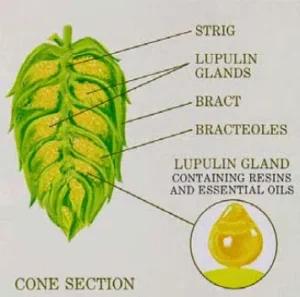The Pacific Northwest Hops
 Oregon State University began a selective breeding program for hops about 60 years ago. In 1972 they were able to release the first variety Cascade. Since that time they have been releasing other successful varieties such as Willamette, Nugget, Mt. Hood and Crystal. These varieties were developed to be disease resistant and to produce higher alpha acid yields, and in fact the program at Oregon State has been referred to as the High Alpha Acid Breeding Program.
Oregon State University began a selective breeding program for hops about 60 years ago. In 1972 they were able to release the first variety Cascade. Since that time they have been releasing other successful varieties such as Willamette, Nugget, Mt. Hood and Crystal. These varieties were developed to be disease resistant and to produce higher alpha acid yields, and in fact the program at Oregon State has been referred to as the High Alpha Acid Breeding Program.
The USDA has released a complete list of all varieties grown in the US, see the USDA Named Hop Variety Descriptions.
The Oregon Hop Commission has all kinds of information on varieties grown in Oregon. Oregon is the second largest producer of hops in the U.S. They are grown mainly in Marion, Polk and Clackamas counties.
Yakima county Washington is another growing area with high-alpha varieties, and has been a source of hop growing for many years, some of the largest hop growing farms in the Northwest are in the state of Washington.
Freshops works primarily with Northwest growers, but also with England, Germany, New Zealand, and the Czech Republic to obtain the finest quality hops for a wide variety for brewing styles.
Lupulin
Hop varieties get their properties or active principles from tiny yellowish glands tucked at the base of the cones’ petals within the bracts or scales. The gland is covered by a waxy skin within which lies all of the hops unique bittering (alpha acids) and aromatic (oil) compounds. These glands are referred to as Lupulin.
The Quality of Hops depends largely on the amount of lupulin they contain. When derived from the fresh hop flowers it is more abundant and of better quality.
Alpha Acids
The bitterness level of a particular hop variety is measured in percent alpha acid by weight. the higher the percentage, the more bitter the hop in direct proportion. As hops age, the alpha acid oxidizes and the bittering potential diminishes. This is why hops should be kept frozen or at least refrigerated. As long as the current years harvest is used, the amount of alpha acid lost is acceptable. Freshops has each variety analyzed for alpha acid and this percentage is indicated on each package. When using hops for bittering, a boil of approximately one hour is recommended to incorporate the bitterness into the wort.
Alpha acids are now the accepted method in the brewing industry for assessing the quality of the hops. Almost everywhere in the world the alpha acid content of each variety and each hop harvest and each individual consignment of hops is measured. Alpha acids play a decisive role in determining prices and quantities bought in the hop trade today.
 Alpha Values
Alpha Values
Using Alpha Acid Percentages
Once you determine how bitter (alpha acid units) you like a particular style of beer, simple algebra is used to balance changing varieties and alpha acid percentages.
Cascade- alpha 5.5% x 2 ounces = 11 alpha acid units Chinook- alpha 10.7% x Q ounces = 11 alpha acid units Q= 11/10.7 = 1.028 ounce
Homebrew Bittering Units (HBU’s)
A measure of the total amount of bitterness in a given volume of beer. Homebrew Bittering Units can easily be calculated by multiplying the percent of alpha acid in the hops by the number of ounces.
For example, if 2 ounces of Northern Brewer hops (9% alpha acid) and 3 ounces of Cascade hops (5 % alpha acid) were used in a 10-gallon batch, the total amount of bittering units would be 33: (2×9)+(3×5)=18+15. Bittering units per gallon would be 3.3 in a 10-gallon batch or 6.6 in a 5 gallon batch, so it is important to note volumes whenever expressing bittering units.
Information about International Bitterness Units (IBUs) can be found on our Homebrewing page.
